Monday, April 5, 2004

There was both good and bad news for investors last week. To get the bad news out of the way first, OPEC ignored pleas from consumers and cut production quotas anyhow. This was more than offset by good news from Japan, where the recovery appears to have legs, and from the U.S., where employment finally began to match growth elsewhere in the economy.
OPEC ignores consumers
OPEC carried through on its threat to lower production quotas beginning April 1st despite pleas from consumer nations not to do so. The group agreed to move ahead with its February 10th decision to lower production quotas by 1 million barrels, to 23.5 million barrels a day. OPEC has targeted prices in the range of $22 to $28 a barrel (using an OPEC-calculated average price of seven different crudes). Its benchmark price has been above that range since December 1st as organization members sought to compensate for a weakening U.S. dollar (oil is priced in U.S. dollars). Prices have not been below the $22 level in over a year. OPEC cuts production at the end of the Northern Hemisphere heating season as demand usually falls. But oil demand has been high and not only from the cold winter. China has increased imports to fuel its burgeoning economy as has Japan. And the revival of growth elsewhere has put pressure on supplies. In the past, cartel members have ignored calls for production cuts and exceeded their quotas. It remains to be seen how many OPEC countries will be tempted by high prices to keep pumping oil and how many non-OPEC oil producers can be persuaded to cut production. A subplot here is that OPEC is facing intensifying pressure from non-member countries, especially Russia, and has intimated that it would offer lower prices to China and Japan to counter Russian supply.
ECB remains frozen in place
The European Central Bank left its key lending rate at 2 percent, saying borrowing costs are low enough to support a "gradual" economic recovery. ECB President Jean Claude Trichet quashed speculation about a rate cut saying that credit costs "remain in line with the maintenance of price stability in the medium term." The euro rose and bonds fell after his comments, which followed the ECB Governing Council meeting on Thursday. Despite tax cuts and export growth, consumer spending especially continues to flail.
The ECB last cut rates in June 2003, when it trimmed borrowing costs by 50 basis points to the current 2 percent - the lowest in any euro country since at least 1946. The policy making interest rate in Britain is 4 percent while in the U.S. it is 1 percent. With inflation under 2 percent and M3 money supply growth finally slowing (albeit above its target growth rate of 4.5 percent), analysts think that the ECB has room to lower rates to boost anemic EMU growth, which registered a paltry 0.3 percent (on the quarter) in the final quarter of 2003.
A rate cut is viewed as a panacea, and has been urged by German Chancellor Gerhard Schroeder and French Prime Minister Jean-Pierre Raffarin, both of whom recently suffered stinging defeats in regional elections because of dissatisfaction with the economy. Rising oil prices as well as indirect taxes could cause an inflationary bump in coming months and that would argue against a rate cut.
But Trichet confused the markets by playing down the chances of an interest rate cut in the coming months, just a week after hinting at one. The mixed signals from the ECB cast renewed doubt on the clarity of the bank's policy pronouncements. Trichet's latest comments in fact sounded surprisingly hawkish to some, disappointing investors who took their frustrations out on the euro.
Global Stock Markets
A first quarter post mortem
A weak March cut into earlier first quarter gains for the 13 indexes followed here. Only indexes in Japan, Australia and Mexico were up on the month. The damage carried over to the quarterly results for the FTSE, DAX, Dow and Nasdaq - all ending below their end-of-2003 levels. However, they were quick to rebound in the first two days of the second quarter, and at week's end only the FTSE was a shade under its 2003 close.
All indexes followed here began the new quarter on a positive note even before the U.S. employment report showed gains above even the most optimistic of expectations. The positive Tankan Survey in Japan boosted investor morale too, signaling that the economy is showing more signs of strength. As a result, all indexes followed here were up on the week.
Global Stock Market Recap

Europe and Britain
Despite some strength, equities remained volatile and investors nervous last week. There was a growing feeling that investors were possibly losing faith in the global economic upturn. At the same time, renewed fears about terrorism following the bombings in Madrid and unrest in the Middle East have surfaced again, returning jitters to financial markets after a resurgence in investors' appetite for risk. Some investors have reacted to the international uneasiness by switching from cyclical stocks most exposed to the upturn into more defensive sectors. The current unease among investors should not be overstated, of course. But what the markets needed was a good set of U.S. employment data, and that's what they got on Friday.
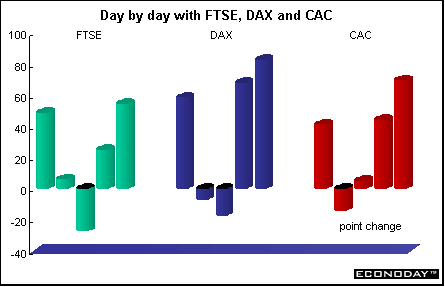
Investors are also braced for the first-quarter earnings season. With high expectations resting on better company results, investors will be looking for companies that dazzle before pushing shares higher.
Asia/Pacific
The second quarter began on a positive note as Asian stocks reacted to Thursday's U.S. data - a fall in U.S. jobless claims and a rise in the purchasing managers' manufacturing survey. All six indexes followed here were up on the week. The positive data boosted optimism that U.S. demand will continue to help exporters such as Nissan and Toyota. Auto makers such as Nissan, with about 80 percent of its operating profit originating in North America, watch U.S. and Canadian indicators fervently. The Nikkei was up for the third consecutive week.
The Hang Seng Index was up for the first week in five. The index rebounded thanks to gains by HSBC Holdings Plc, the world's second-biggest bank by market value and which also relies heavily on North American markets for profitability.

In the week ending March 26th, foreign investors continued to be heavy buyers of Japanese stocks according to Ministry of Finance data. Foreign investors were, however, net sellers of Japanese bonds. Despite the period encompassing the last full week of the Japanese fiscal year, Japanese investors were net buyers of foreign stocks and continued to be heavy net buyers of foreign bonds, perhaps reflecting demand at the US 2-year auction.
End of fiscal year for Japan
Japanese stocks rose, with the Nikkei and Topix indexes posting their biggest fiscal year gains in 31 years! The Nikkei jumped 47 percent in the fiscal year ending March 31st and the Topix soared 49 percent. Both indexes had been down in the last three fiscal years. For the first three months of calendar year 2004, the Nikkei is up 9.7 percent and the Topix has added 13 percent.

Currencies
After a week of trading within a relatively narrow range building up to the ECB meeting, the euro was hit hard by the strength of the U.S. employment situation report Friday morning. The euro had picked up after European Central Bank President Jean Claude Trichet said he still expects a gradual economic recovery in the region. The euro had fallen previously after Trichet spurred speculation about a rate cut. He said in an interview with the Handelsblatt newspaper on March 24th that the bank may reduce its growth forecasts if consumer confidence doesn't improve.
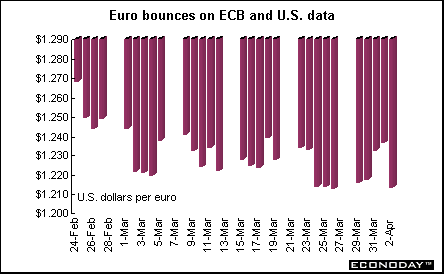
The yen jumped against the dollar after the Bank of Japan's Tankan survey of business sentiment showed that confidence among large manufacturers is at its highest level since 1997. This combined with the end of the fiscal year on March 31st as well as the disappearance of the Bank of Japan from the currency markets boosted the yen to a 4-year high of 103.4 yen to the U.S. dollar. Analysts seem to agree that the Japanese economy is accelerating and the recovery seems to have legs now that domestic demand is finally showing signs of life.
On the last day of its fiscal year, the Bank of Japan stood aside as the yen hurtled through the �105 barrier to hit a four-year high against the dollar. The yen staged a swift ascent after crashing through �105, long regarded as the tolerance threshold for policymakers determined to prevent a strengthening yen from jeopardizing an export-led recovery. Comments by Japan's finance minister, that Japan had grown resilient to the stronger yen, propelled the currency even higher.
The total Japanese yen-selling intervention in the foreign exchange markets amounted to �4.703 trillion in March according to the Ministry of Finance. At current exchange rates, the total represents purchases of $45.2 billion. In February, MOF spent �3.342 trillion buying dollars on foreign exchanges to smooth the yen's rise, following a record monthly amount in excess of �7 trillion in January.

Indicator scoreboard
EMU - March flash harmonized index of consumer prices was up 1.6 percent when compared with last year. No detail is available for flash reports. In order to compute these estimates, Eurostat uses early price information provided by Germany, Italy and by other member countries if available along with energy price information.

February seasonally adjusted unemployment rate remained at 8.8 percent for the 12th month. Spain continues to have the highest rate of unemployment - 11.2 percent - while Luxembourg has the lowest - 4 percent.

March NTC purchasing managers' index increased to 53.3, a 39-month high, from 52.5 in February. The index was up in Germany, France and Italy. New orders and output accelerated at a brisk pace. A reading above the 50 level indicates expansion while a reading below 50 signals contraction.
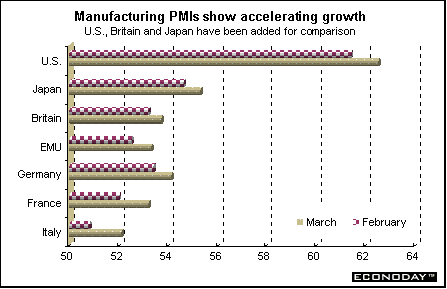
February producer price index inched up 0.1 percent and was unchanged when compared with last year. Energy prices were down on the month. Excluding energy, the PPI was up 0.3 percent and 0.7 percent on the year.
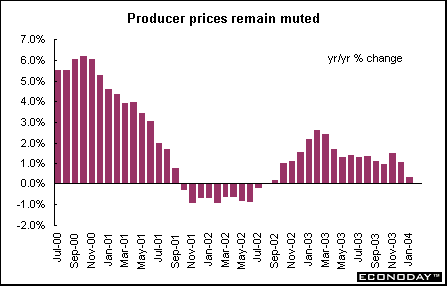
EU - March EU economic sentiment index inched up to 96 from 95.9 in February. Improvement in construction and retail offset stagnating industry and consumer confidence. Most of the data were collected prior to the Madrid terrorist attacks so its impact is still unknown. Both industrial and consumer sentiment were unchanged from their February levels of minus 7 and minus 14 respectively. Confidence improved in both the construction and retail sectors while the service sector remained unchanged from February.

Germany - February Bundesbank retail sales were up 0.6 percent and down 1.1 percent when compared with last year. Excluding autos and gasoline stations, retail sales jumped 1.2 percent but were down 0.9 percent on the year. As is frequently the case, the statistics office data excluding autos and gasoline stations were much different, showing an increase of 0.3 percent but were unchanged on the year. The differences between the two series are due to the seasonal adjustment methods used by the Bundesbank (Census X-11 Arima) and Statistics Office (Berlin Method). Both agencies use the same raw data for their calculations. The Bundesbank data are preferred because this is the series which is used to calculate GDP.

France - February seasonally adjusted unemployment rate remained at 9.6 percent for the second month. The number of jobless was down by 5,000. The labor market data are less a reflection of renewed hiring than more restrictive rules for unemployment insurance that ended benefits for some 180,000 long-term jobseekers at the start of the year. The new rules will end benefits for half a million or more jobseekers over the next two years.

February producer price index was unchanged and slipped 0.1 percent when compared with last year. Excluding food and energy, the PPI was up 0.2 percent both for the month and for the year. Energy prices were down 0.6 percent and sank 4.6 percent on the year.

Italy - First quarter seasonally adjusted unemployment rate remained at 8.5 percent. This is the lowest rate since October 1992. ISTAT said that the labor report showed a continuation of several recent trends - a gradual slowing in job growth, a disproportionate increase in job growth among the older age bracket, and growing numbers of people withdrawing altogether from the labor market. The decline in job seekers was due partly to people withdrawing from the labor market rather than an increase in people finding jobs.
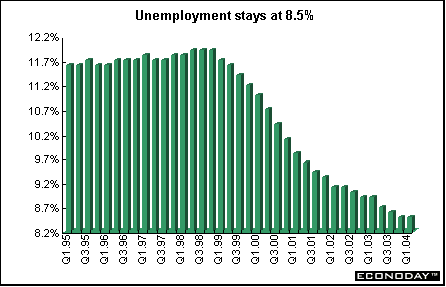
February producer price index was unchanged both on the month and on the year. Both consumer goods and energy product prices were down. Excluding energy, the PPI was up 0.2 percent and 1.1 percent on the year.
Britain - March nationwide house price index was up 1.4 percent and 16.7 percent when compared with last year. The average property costs Stg142,584. House price growth was widespread with most regions experiencing a pickup.

March Halifax house price index was up 2.2 percent and 18.5 percent when compared with last year. The average price of a house rose to Stg151,467. Halifax said that strong demand and tight supply continue to push house prices upward. House prices increased in all regions during the first quarter. Both Nationwide and Halifax generally follow along the same track.

March Chartered Institute of Purchasing Supply (CIPS) purchasing managers' index increased to 53.7 from 53 in the previous month. Higher output and new orders contributed to the increase. Export orders also expanded in March but not as rapidly as the prior month.
Asia
Japan - February seasonally adjusted industrial production dropped 3.7 percent but was up 3.7 percent when compared with the previous year. Industries that contributed to the decline were transport equipment, electronic parts and devices, and information and communication electronics equipment. Commodities that contributed to the decrease included large passenger cars and personal computers. Capacity utilization was at 76 percent.
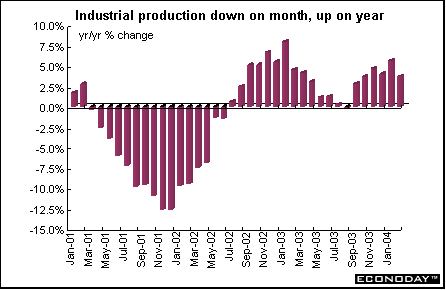
February unemployment rate remained at 5 percent for the second month. Employment was down by 10,000 jobs and the number of unemployed people rose to 3.35 million. Companies remain cautious about their labor plans, with major companies announcing job cuts. The number of temporary employees who are on a contract with a company for more than one month but less than a year rose to 6.15 million people in 2003.
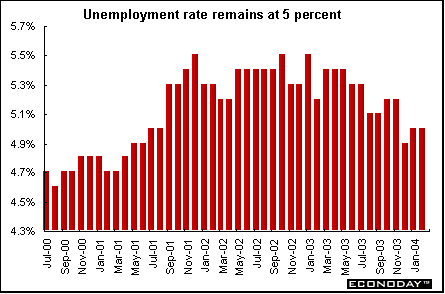
March Reuters/Nomura/JMMA Purchasing Managers' Index rose from 54.6 in February to 55.3, indicating an increase in the rate of expansion for the first time since November. The index has remained above the 50 no-change mark for ten successive months, indicating a sustained period of sector expansion. The PMI was driven up primarily by increases in the output and new orders indexes. Manufacturing output rose for the tenth straight month. The improved rate of growth contrasted with an easing in the pace seen over the previous three months.
First quarter Tankan Survey of large manufacturers improved to 12 from 7 in the prior quarter while the index for small manufacturers improved from minus 10 to minus 3. The large non-manufacturers index improved to 5 from 0 in December for its first positive reading since November 1996. The Tankan's sentiment indexes measure the percentage of companies saying business conditions are better minus the percentage saying things are worse. The BOJ has made many changes to the survey among which is how the BOJ categorizes companies. Previously, companies were grouped according to the number of employees, but the new method ranks the firms according to their capital. A company is now considered large if it has �1 billion ($9.6 million) or more in capital. Previously, companies were considered large if they had more than 1,000 employees. The Tankan, Japan's the most closely watched index of business confidence, surveys 10,800 companies on the outlook for sales, profits, spending and employment. Only the data for the 4th quarter of 2003 were revised to reflect the new classification, therefore the data are not comparable for prior surveys.
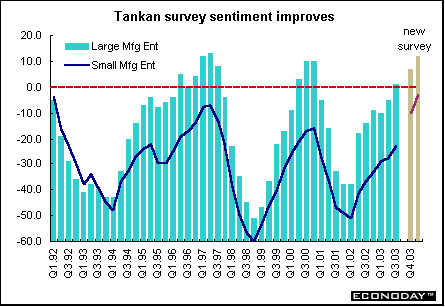
Australia - February retail sales inched up 0.1 percent but soared 8.3 percent when compared with last year. Sales of household goods fell 0.9 percent, the second decline in three months. But sales at department stores jumped 2.3 percent and sales of clothing rose 0.6 percent.

Americas
Canada - January gross domestic product at basic prices slipped 0.1 percent but was up 1.7 percent when compared with last year. Weak North American auto sales affected the manufacturing, retailing, wholesaling and transportation sectors. Weak oil & gas production and exploration offset a sharp gain in utilities. Less consumer demand for new housing reduced residential construction and the activities of real estate agents and brokers. Electricity generation jumped 3.7 percent and natural gas distribution rose 8.5 percent because of extremely cold weather across the country.

February industrial product price index was up 1.8 percent but was down 2.5 percent when compared with last year. Many prices were influenced by the exchange rate such as those for motor vehicles and other transport equipment. Higher prices for lumber and other wood products resulted from strong demand. Primary metal products were up as prices continue to increase for copper, nickel, aluminum, and lead products. On the year, February was the 11th consecutive month that the IPPI has declined.
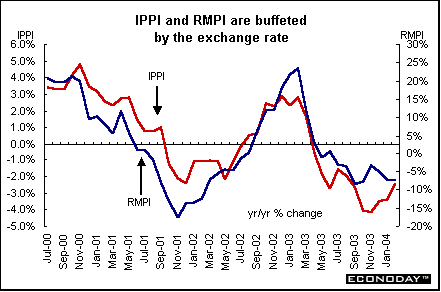
February raw materials price index was up 3.4 percent but sank 7.4 percent when compared with last year. Mineral fuels were responsible for about half of the monthly increase in the RMPI. Crude oil prices were up 3.4 percent from January as a result of tight supply and increased demand because of colder temperatures. Prices for non-ferrous metals soared 9.1 percent as strong demand continued for copper, lead, zinc and nickel concentrates. Mineral fuels were down 14.4 percent from a year ago with crude oil prices declining 17.2 percent. If mineral fuels had been excluded, the RMPI would have declined 0.9 percent.
Between January and February, the value of the U.S. dollar strengthened against the Canadian dollar, pushing up prices of commodities that are quoted in U.S. dollars, particularly in the case of motor vehicles, lumber products and pulp and paper products. As a result, the total IPPI excluding the effect of the exchange rate would have risen 1.1 percent instead of 1.8 percent. However, on the year, the Canadian dollar is much stronger. Consequently, the IPPI excluding the effect of the exchange rate would have increased 1.1 percent rather than declining 2.5 percent from February 2003 to February 2004.
Bottom line
The Reserve Bank of Australia, Bank of England and Bank of Japan meet this week. The RBA will let us know their rate decision Wednesday morning Canberra time (Tuesday night on the U.S. Eastcoast). Analysts expect the RBA to leave rates unchanged. The Australian dollar was the best performing currency against the U.S. dollar last year. But its appreciation has stalled on speculation that the Bank, which increased rates in both November and December, will delay raising interest rates again. Policy makers also want to discourage people from taking on too much debt. Consumer borrowing has been rising at the fastest pace in 15 years. Last year's increases that brought the Bank's rate to 5.25 percent were aimed at slowing house price inflation and the pace of home lending. But it subsequently sent business optimism tumbling and slowed job creation.
Analysts are unsure about what the Bank of England will do. The pressure on the Bank of England to raise interest rates 25 basis points to 4.25 percent next week intensified when mortgage equity withdrawal hit a record high at the end of last year, surpassing the peak of the late 1980s housing boom. In spite of many predictions to the contrary, house prices remain robust. But fears over high borrowing levels and the Bank of England's focus on consumer debt have driven interest rate expectations in the markets higher. There is a growing murmur that the Bank might opt for a one-off big hit on rates to rein in the consumer. The Bank has insisted that it does not want to rock markets with such "shock therapy", but the suggestion of it among some market participants has been enough to increase investors' jitters.
Last - the Bank of Japan. It will be interesting to see if the BoJ refers to the abrupt end of its massive currency intervention now that the fiscal year is at an end and profits have been safely repatriated.
Looking Ahead: April 5 through April 9, 2004




